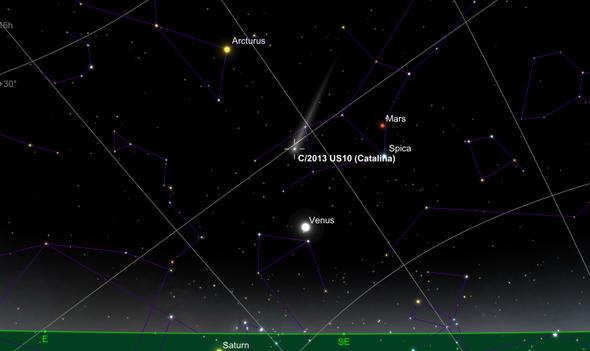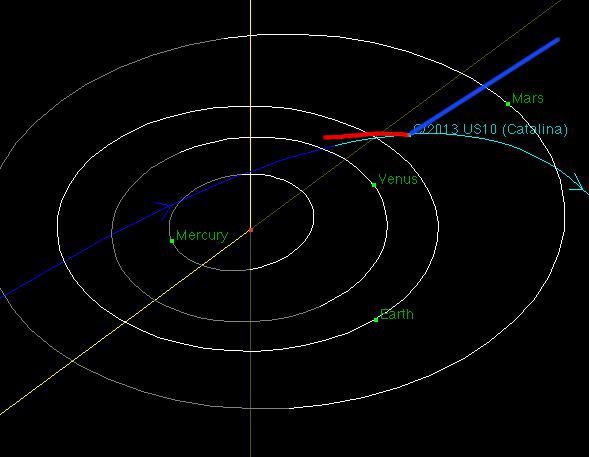If you get up early enough over the next few weeks—a couple of hours before sunrise should do it—and look east, you’ll see the brilliant beacon of the planet Venus. Fairly close to it in the sky, but not so obvious is a visitor to these parts; one that is just passing through. Literally.
The visitor is the comet C/2013 US10 (Catalina); most people are just calling it Comet Catalina (the official name has a bit more complicated nomenclature). There are a couple of very cool things about this comet you should know about, but before I get to that part let me tell you how to see it.
Although it’s bright as comets go, for now you’ll probably need binoculars to observe it unless you have pretty dark skies. It’s about magnitude 5 or 6 right now, which means it’s technically visible to the unaided eye, but it’ll be tough. Any optical aid you have like binocs or a good ‘scope would help.
Its orbit is tilted rather severely to the Earth’s; it has an inclination of 149° (or, if it helps, about 30° from Earth’s but moving around the Sun in more or less the opposite sense from Earth). In the sky it’s moving in a northerly direction, so folks north of the equator will see it higher in the morning every day. It will be closest to Earth on Jan. 17, when it’ll be roughly 100,000,000 kilometers away (which is close as comets go, but still a long way). After that it’ll pull away and start to dim, so seeing it will be harder.

Map made using Sky Safari 4
Sky and Telescope has a map of the sky that’ll help you see it. While looking at its path through the stars I was surprised to see that on Jan. 1, 2016, it’ll be a mere 0.4° from Arcturus, one of the brightest stars in the sky! That separation is less than the apparent width of the full Moon, so we’re talking close. Arcturus is an orange subgiant (a star that was once much like the Sun but is well on its way to dying), so the contrast of colors should be striking. It should make for some gorgeous photos!
A couple of weeks later it passes near the Big Dipper (and it’ll be up at a more decent hour, after about 10 p.m. local time), so again, cameras at the ready, folks. In the meantime, here’s some inspiration for photography.
So what’s so special about this comet? Well, as you can see from the gorgeous photo at the top of this post, it has two tails pointing in different directions! Many comets have two tails—one made of gas and the other from dust. As the comet nears the Sun, it warms up. Comets have lots of ice in them, which turns directly into a gas as it heats up (this is called sublimation).
Ultraviolet light from the Sun ionizes the gas (strips an electron or electrons from the atoms making it up), giving it an electric charge. This makes it very sensitive to the solar wind, which is a stream of subatomic particles blowing off the Sun at very high speed. This grabs onto the ionized comet gas and blows it straight out, away from the Sun.
At the same time, as the gas sublimates, it releases dust embedded in it. This doesn’t get affected much by the solar wind, but the intense sunlight itself exerts a tiny pressure on it, gently pushing it away from the comet. That tends to fall behind the comet in the orbit, like dirt being blown off a dump truck.
So you get two tails pointing in different directions. In the case of Catalina, we see it at an angle that makes it look like they point in opposite directions, but that’s just perspective. The diagram below should hopefully make that clear.

Diagram by NASA/JPL, modified by Phil Plait
But there’s another thing about this comet that’s pretty astonishing: This is the first and only pass it will ever make to the inner solar system. Catalina is coming from very deep space, probably out in the Oort cloud, the vast repository of icy bodies far, far beyond the orbit of Neptune. Its orbit may have originally been millions of years long! But something gave it a kick—perhaps a star that passed a couple of light years away a million years ago, or the tides from the galaxy itself—and dropped it toward the Sun. This kick also gave it a teeny bit more energy, just enough added speed that it achieved escape velocity. That means it has enough energy to escape from the Sun altogether, and is on its way out of the solar system forever (this is technically called a hyperbolic orbit).
So this is it. If you want to see this comet, you’d better take the chance over the next month or so. Once it’s gone, it’s gone.
That New Year’s conjunction with Arcturus sounds like a pretty good opportunity to me. They’ll be high in the sky in the east on that date before sunrise, and easy to spot. If I only get one chance in a lifetime to see it, that’s when I’ll take my shot. Seems like a great way to ring in a new year.
